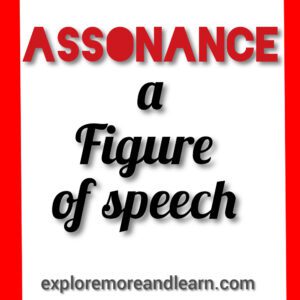Assonance is the repetition of the same or similar vowel sounds within words, phrases or sentences. The words have to be close enough together for the repetition to be noticeable. Assonance is a figure of speech similar to alliteration, because it also involves repetition of sounds.
Examples of Assonnance
“I might like to take a flight to an island in the sky.”
“If I bleat when I speak it’s because I just got . . . fleeced.”
•“It beats . . . as it sweeps . . . as it cleans!”
” The light of the fire is a sight. ” (repetition of the long i sound)
“Go slow over the road.” (repetition of the long o sound)
The sentence, the light is a bright sight, demonstrates assonance with the emphasis on the “i” vowel.
Assonance most often refers to the repetition of internal vowel sounds in words that do not end the same. For example, “It beats . . . as it sweeps . . . as it cleans!” Here we have repetition of the long vowel “e“ and the words containing this vowel do not end in perfect rhymes.
Examples of Assonance in Literature:
William Wordsworth uses assonance to reflect the calm and thoughtful mood of his poem “Daffodils”:
“Beside the lake, beneath the trees,
Fluttering and dancing in the breeze…
2. William Blake’s “Tyger”: “Tyger, Tyger burning bright in the forest of the night” (repetition of the long i sound)
Uses of Assonance
Assonance creates a sense of rhythm and lyrical effect. In both poetry and prose, assonance’s repetition of sound can give language a musical element, as well as emphasize sounds or words. It can affect the tone, and mood of a text.
- This vs It
- Bad in or Bad at
- Identify Nouns
- Nouns and Their Kinds
- Gerund in English Grammar
- Birds and Their Sounds
- Powerful Adverbs for Writing
- Adverbs in English Grammar
- Worksheet – Abstract Nouns
- Simple Past Tense: Rules and Examples
- Little vs A Little vs The Little
- Ones vs One’s vs Once: Understanding the Differences
- Homophones with Examples
- Idiom: Bury the Hatchet
- Parts of Speech
